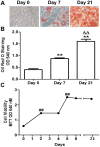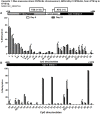Expression of Caveolin 1 is enhanced by DNA demethylation during adipocyte differentiation. status of insulin signaling
- PMID: 24751908
- PMCID: PMC3994010
- DOI: 10.1371/journal.pone.0095100
Expression of Caveolin 1 is enhanced by DNA demethylation during adipocyte differentiation. status of insulin signaling
Abstract
Caveolin 1 (Cav-1) is an essential constituent of adipocyte caveolae which binds the beta subunit of the insulin receptor (IR) and is implicated in the regulation of insulin signaling. We have found that, during adipocyte differentiation of 3T3-L1 cells the promoter, exon 1 and first intron of the Cav-1 gene undergo a demethylation process that is accompanied by a strong induction of Cav-1 expression, indicating that epigenetic mechanisms must have a pivotal role in this differentiation process. Furthermore, IR, PKB-Akt and Glut-4 expression are also increased during the differentiation process suggesting a coordinated regulation with Cav-1. Activation of Cav-1 protein by phosphorylation arises during the differentiation process, yet in fully mature adipocytes insulin is no longer able to significantly increase Cav-1 phosphorylation. However, these long-term differentiated cells are still able to respond adequately to insulin, increasing IR and PKB-Akt phosphorylation and glucose uptake. The activation of Cav-1 during the adipocyte differentiation process could facilitate the maintenance of insulin sensitivity by these fully mature adipocytes isolated from additional external stimuli. However, under the influence of physiological conditions associated to obesity, such as chronic inflammation and hypoxia, insulin sensitivity would finally be compromised.
Conflict of interest statement
Figures





Similar articles
-
Effect of TNF-Alpha on Caveolin-1 Expression and Insulin Signaling During Adipocyte Differentiation and in Mature Adipocytes.Cell Physiol Biochem. 2015;36(4):1499-516. doi: 10.1159/000430314. Cell Physiol Biochem. 2015. PMID: 26159107
-
Effects of high glucose on caveolin-1 and insulin signaling in 3T3-L1 adipocytes.Adipocyte. 2015 Dec 8;5(1):65-80. doi: 10.1080/21623945.2015.1122856. eCollection 2016 Jan-Mar. Adipocyte. 2015. PMID: 27144098 Free PMC article.
-
Transcriptional and epigenetic mechanisms underlying enhanced in vitro adipocyte differentiation by the brominated flame retardant BDE-47.Environ Sci Technol. 2014 Apr 1;48(7):4110-9. doi: 10.1021/es405524b. Epub 2014 Mar 11. Environ Sci Technol. 2014. PMID: 24559133 Free PMC article.
-
Epigenetic modifications of the Zfp/ZNF423 gene control murine adipogenic commitment and are dysregulated in human hypertrophic obesity.Diabetologia. 2018 Feb;61(2):369-380. doi: 10.1007/s00125-017-4471-4. Epub 2017 Oct 24. Diabetologia. 2018. PMID: 29067487 Free PMC article.
-
Molecular regulation and clinical significance of caveolin-1 methylation in chronic lung diseases.Clin Transl Med. 2020 Jan;10(1):151-160. doi: 10.1002/ctm2.2. Epub 2020 Apr 16. Clin Transl Med. 2020. PMID: 32508059 Free PMC article. Review.
Cited by
-
Caveolin-1 in the regulation of cell metabolism: a cancer perspective.Mol Cancer. 2016 Nov 16;15(1):71. doi: 10.1186/s12943-016-0558-7. Mol Cancer. 2016. PMID: 27852311 Free PMC article. Review.
-
FABP7 Regulates Acetyl-CoA Metabolism Through the Interaction with ACLY in the Nucleus of Astrocytes.Mol Neurobiol. 2020 Dec;57(12):4891-4910. doi: 10.1007/s12035-020-02057-3. Epub 2020 Aug 19. Mol Neurobiol. 2020. PMID: 32812201 Free PMC article.
-
The importance of caveolin as a target in the prevention and treatment of diabetic cardiomyopathy.Front Immunol. 2022 Nov 2;13:951381. doi: 10.3389/fimmu.2022.951381. eCollection 2022. Front Immunol. 2022. PMID: 36405687 Free PMC article. Review.
-
Lifestyle intervention in individuals with impaired glucose regulation affects Caveolin-1 expression and DNA methylation.Adipocyte. 2020 Dec;9(1):96-107. doi: 10.1080/21623945.2020.1732513. Adipocyte. 2020. PMID: 32125224 Free PMC article.
-
Caveolin-1 as a possible target in the treatment for acne.Exp Dermatol. 2020 Feb;29(2):177-183. doi: 10.1111/exd.14063. Epub 2019 Dec 9. Exp Dermatol. 2020. PMID: 31769542 Free PMC article. Review.
References
-
- Petronis A (2010) Epigenetics as a unifying principle in the aetiology of complex traits and diseases. Nature 465(7299): 721–727. - PubMed
-
- Zhu JG, Ji CB, Zhang CM, Zhu GZ, Shi CM, et al. (2012) Differential DNA methylation status between human preadipocytes and mature adipocytes. Cell Biochem Biophys 63(1): 1–15. - PubMed
Publication types
MeSH terms
Substances
LinkOut - more resources
Full Text Sources
Other Literature Sources
Medical
Miscellaneous

